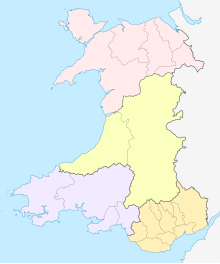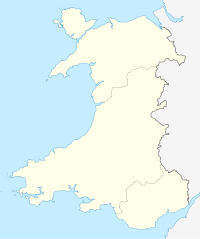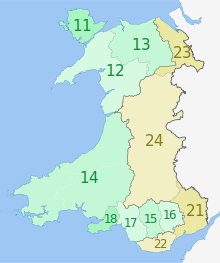The subdivisions of Wales constitute a hierarchy of administrative divisions and non-administrative ceremonial areas.
For the purposes of local government, the country is divided into principal areas, of either counties or county boroughs, and communities. The current system is the result of incremental reform which has its origins in legislation enacted in 1972 and 1994.
Administrative
Principal areas
Main article: Principal areas of WalesThere are 22 principal areas of Wales. They were established on 1 April 1996 by the Local Government (Wales) Act 1994 (1994 c. 19). Eleven are styled "counties", including the cities of Cardiff and Swansea, and eleven are styled "county boroughs", including the cities of Newport and Wrexham.
The location of each council headquarters is indicated by a yellow marker. County boroughs are marked by a dagger (†).
 |
|
| Areas marked † are county boroughs, while unmarked areas are counties. Welsh-language forms are given alongside the English where they differ. | |
Name changes
Five of the principal areas use different names to those given in the Local Government (Wales) Act 1994. In each case the council renamed the area immediately, with the changes taking effect on 2 April 1996. The changes were:
- Conwy from "Aberconwy and Colwyn"
- Isle of Anglesey from "Anglesey"
- Gwynedd from "Caernarfonshire and Merionethshire"
- Ceredigion from "Cardiganshire"
Other smaller changes were also made, such as:
- Neath Port Talbot from "Neath and Port Talbot"
Communities
Main article: Community (Wales) See also: List of communities in WalesAt the lowest level of administrative subdivision in Wales are the communities, into which each principal area is subdivided. They may have elected community councils which perform a number of roles, such as providing local facilities, and representing their communities to larger local government bodies. Community councils are the equivalent of English parish councils. A community council may call itself a "town council" if it so wishes. The councils of three communities with city status – Bangor, St Asaph, and St Davids – are known as "city councils". Communities which are too small to have a council may have a community meeting instead: an example of direct democracy. The communities in the urban areas of the cities of Cardiff, Swansea and Newport do not have community councils.
Non-administrative
Preserved counties
Main article: Preserved counties of WalesFor ceremonial purposes of Lieutenancy and Shrievalty, Wales is divided into eight preserved counties. These were based on the counties (created by the Local Government Act 1972) which were used for local government and other purposes between 1974 and 1996.
There are eight preserved counties:
Historic
Former districts
Main article: Districts of WalesHistoric counties
Main article: Historic counties of WalesThe historic counties of Wales are ancient subdivisions of Wales, used for various functions for several hundred years. Pembrokeshire was formed as a county palatine in 1138. In the south east, Norman advancement led to the creation of marcher lordships, such as Glamorgan, which served as semi-autonomous administrative divisions, although these were not counties in the true sense as they lacked the formal structure. Some towns within these areas did, however, receive charters which outlined rights and duties in much the same way as a borough. Counties in the strict sense first appeared with the establishment of Cardiganshire and Carmarthenshire in the 1240s. In 1284 the Principality of Gwynedd was divided into three counties: Anglesey, Caernarvonshire and Merionethshire. Before the end of the century, Flintshire had also become a county, and thus nearly half the territory of Wales was under the rule of the English Crown. While the arrangement did not officially bring the marcher lordships in the South directly under the King's control, many such lordships were held by the King personally, although some remained under the semi-autonomous control of powerful local families. The formation of counties was completed under the Laws in Wales Act 1535, which created Montgomeryshire, Denbighshire, Radnorshire, Brecknockshire and Monmouthshire, many from existing marcher lordships now recreated as counties proper.
These 13 counties were the main administrative subdivisions of Wales from 1536 until the implementation in 1974 of the Local Government Act 1972, although the definition and role of the smaller county boroughs within the counties during that period saw considerable change, as it did across the United Kingdom.
Cantrefi and Commotes
Main articles: cantref and commoteHundreds
Main article: List of hundreds of WalesRegions
Main article: Regions of WalesRegional partnership areas

Wales is subdivided into four regional areas for its Corporate Joint Committees and its conterminous regional economic growth deals. City deals have been agreed for the Cardiff Capital Region and Swansea Bay City Region, which cover south-east and south-west Wales respectively, and growth deals have been agreed for Mid Wales (Growing Mid Wales) and North Wales (Ambition North Wales). There are four equivalent CJCs which may oversee the deals, and they also cover Mid Wales, North Wales, South East Wales, and South West Wales. The CJC's were established by The Local Government and Elections (Wales) Act 2021. CJCs have powers relating to economic well-being, strategic planning and the development of regional transport policies.
Senedd
Main article: Senedd electoral regionsOther subdivisions
Service areas
Police services
There are four police forces in Wales: Dyfed-Powys Police, Gwent Police, North Wales Police and South Wales Police.
 1
2
3
4
1
2
3
4
|
|
Fire and rescue services
There are three fire and rescue services in Wales, established in 1996: Mid and West Wales Fire and Rescue Service, North Wales Fire and Rescue Service and South Wales Fire and Rescue Service.
 1
2
3
1
2
3
|
|
Health boards
There are seven local health boards in Wales.
 1
2
3
4
5
6
7
1
2
3
4
5
6
7
|
Trunk road agents
Main article: Trunk road agentTrunk road agents are partnerships between two or more local authorities for the purposes of managing, maintaining, and improving the network of trunk roads (including any motorways) in their respective areas. Each trunk road agent can employ Welsh Government traffic officers. There are two agents, covering North and Mid Wales and South Wales.

|
North and Mid Wales Trunk Road Agent South Wales Trunk Road Agent |
International Territorial Level
Wales is divided into statistical regions by the UK's Office for National Statistics, using the International Territorial Level geocode standard since 2021. Before Brexit, as part of the European Union and Eurostat, the system used was Nomenclature of Territorial Units for Statistics (NUTS). Wales is a level 1 ITL region alongside Scotland, Northern Ireland and the 9 statistical regions of England, with the code "TLL". It is subdivided into two ITL 2 regions, which are themselves divided into twelve ITL 3 regions.
| ITL 1 | Code | ITL 2 | Code | ITL 3 | Code |
|---|---|---|---|---|---|
| Wales | TLL | West Wales and the Valleys | TLL1 | Isle of Anglesey | TLL11 |

|
Gwynedd | TLL12 | |||
| Conwy and Denbighshire | TLL13 | ||||
| South West Wales (Ceredigion, Carmarthenshire, Pembrokeshire) | TLL14 | ||||
| Central Valleys (Merthyr Tydfil, Rhondda Cynon Taff) | TLL15 | ||||
| Gwent Valleys (Blaenau Gwent, Caerphilly, Torfaen) | TLL16 | ||||
| Bridgend and Neath Port Talbot | TLL17 | ||||
| Swansea | TLL18 | ||||
| East Wales | TLL2 | Monmouthshire and Newport | TLL21 | ||
| Cardiff and Vale of Glamorgan | TLL22 | ||||
| Flintshire and Wrexham | TLL23 | ||||
| Powys | TLL24 | ||||
Electoral
Wales is divided into various electoral districts:
- UK Parliament constituencies in Wales
- Senedd constituencies and electoral regions
- List of electoral wards in Wales
Settlement-based
Built-up areas
Main article: List of built-up areas in Wales by populationCities
See also: List of cities in WalesThere are seven cities in total in Wales: in addition to the four principal areas with city status (Cardiff, Swansea, Newport and Wrexham), the communities of Bangor, St Davids and St Asaph also have the status. City status is granted by letters patent.
- Bangor – time indeterminate
- Cardiff – 1905
- Swansea – 1969
- St Davids – 1994
- Newport – 2002
- St Asaph – 2012
- Wrexham – 2022
St Asaph, as the seat of a bishopric, was historically referred to as a city, and was described as such in the 1911 Encyclopædia Britannica. The status was, however, not officially recognised for many years. When city status was restored to St Davids in 1994, St Asaph town council submitted a petition for the same purpose. The petition was refused as, unlike St Davids, there was no evidence of any charter or letters patent in the past conferring the status. Applications for city status in competitions in 2000 and 2002 were unsuccessful. However, city status was finally granted to St Asaph in 2012 as part of the Queen's Diamond Jubilee celebrations: St Asaph was selected "to recognise its wealth of history, its cultural contribution and its metropolitan status as a centre for technology, commerce and business". Wrexham was awarded city status as part of the Queen's Platinum Jubilee in September 2022.
See also
References
- "Local Government (Wales) Act 1994". www.legislation.gov.uk. Archived from the original on 14 September 2017. Retrieved 8 May 2018.
- "No. 56573". The London Gazette. 21 May 2002. p. 6160.
- "Newport City Council". Newport City Council. 4 December 2010. Archived from the original on 9 December 2010. Retrieved 5 March 2011.
- "The Residuary Body for Wales (Levies) Regulations 1996". www.opsi.gov.uk. Archived from the original on 9 December 2009. Retrieved 8 May 2018.
- "Community councils". Cardiff Council. Archived from the original on 6 September 2018. Retrieved 7 April 2017.
- "Community/Town Council contact details". City and County of Swansea. 30 September 2003. Archived from the original on 8 April 2017. Retrieved 7 April 2017.
- "Community council contact details". Newport City Council. Archived from the original on 8 April 2017. Retrieved 7 April 2017.
- "Local Government and Elections (Wales) Act 2021".
- "The South West Wales Corporate Joint Committee Regulations 2021" (PDF).
- Beckett, J V (2005). City Status in the British isles, 1830 – 2002. Aldershot: Ashgate Publishing. pp. 133–135. ISBN 0-7546-5067-7.
- "Three towns win city status for Diamond Jubilee". BBC News. 2012-04-18. Archived from the original on 2012-04-25. Retrieved 2012-04-18.
- "Queen's Jubilee: Wrexham becomes Wales' seventh city". BBC News. 2022-05-20. Retrieved 2022-05-21.
- "The City of Wrexham: History made as city status is granted". The Leader. 20 May 2022. Retrieved 2022-05-21.
- "Official – Wrexham is now a city". Wrexham.com. Retrieved 2022-09-01.